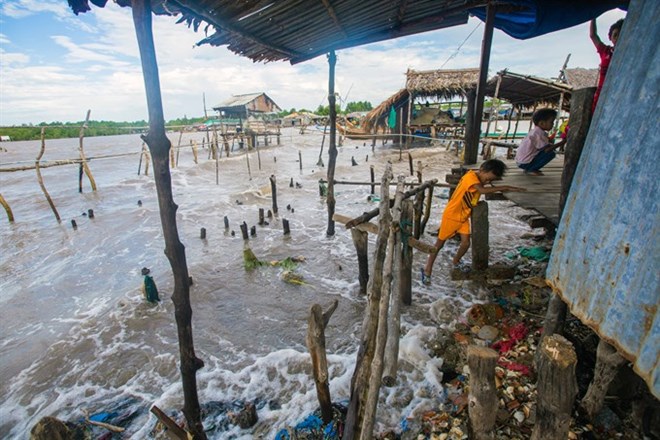The southernmost province of Ca Mau is taking actions to prevent coastal erosion, which has been getting worse over the past few years.

Ca Mau is facing serious coastal erosion
Ca Mau has about 109,000 hectares of forests, mostly submerged ones, which account for 77 percent of the forest area in the Mekong Delta. It boasts a 254-kilometre-long coast – the longest coast among Vietnam’s littoral provinces and cities.
Before 2000, alluvium continually settled in the province’s western coast, spreading about 50 – 120 metres to the sea each year.
However, climate change impacts, including sea level rise, have made coastal erosion in Ca Mau more and more unpredictable, along both western and eastern coasts.
Along the western coast, the sea encroaches 20 – 25 metres deep into the land every year, even 50 metres in some locations. Meanwhile, 45 – 50 metres of land is washed away each year in the eastern coast.
Coastal erosion has happened at a dangerous level and frequently over the past years. Some stretches have been eroded severely, even to the foot of sea dykes.
Surveys show that more than 40 kilometres of coast has suffered from erosion at the dangerous level that may destroy sea dykes and greatly affect residential communities. Of that length, critically dangerous erosion has been recorded on over 20 kilometres of coast.
Erosion is forecast to be more serious and unpredictable in the time ahead.
In the face of that problem, Ca Mau has made efforts to deal with erosion at important places by building more than 11,000 metres of stone embankments worth some 511 billion VND (22.5 million USD).
Such programmes have initially proved effective as they have helped ease erosion while retaining sediment which will gradually form alluvial grounds for grey mangroves to grow. The expansion of this plant species will in turn create protection forests saving sea dykes from climate change impacts.
Provincial authorities have made plans for developing 26,133 hectares of coastal protection forests, accounting for 24.2 percent of local forestry land. Of that area, protection forests at the critical level cover 10,475 hectares, making up 40.1 percent of the total protection forest area in Ca Mau.
From now to 2018, the province is going to plant 920 hectares of coastal protection forests at a cost of 90 billion VND (nearly 4 million USD).
To conserve and promote specific values of the submerged forest ecosystem, prevent riverbank and coastal erosion, and protect agricultural production, Ca Mau will need about 1.5 trillion VND (66.2 million USD) in financial support from the Government to carry out embankment building and afforestation projects, according to Deputy Director of the provincial Department of Agriculture and Rural Development Tran Van Thuc.
Chairman of the Ca Mau People’s Committee Nguyen Tien Hai recently ordered the agriculture department to coordinate with the provincial Department of Planning and Investment, the Department of Finance, the National Park of Cape Ca Mau, authorities of the districts of U Minh, Tran Van Thoi, Phu Tan, Nam Can, Ngoc Hien and Dam Doi, along with relevant agencies to seriously implement the Government’s Decree 119/2016-ND-CP on some policies on the management, protection and sustainable development of coastal forests in response to climate change. This decree was issued by the Government in August this year.
Accordingly, the localities have to survey and use coastal areas which have been planned for planting commercial forests or other purposes and severely affected by shifting sand to plant protection forests. They are also tasked with removing construction facilities that may influence coastal protection forests’ functions from these areas.
Those activities are considered necessary moves due to increasing impacts of climate change. If effective solutions are not made immediately, consequences will be extremely heavy.
VNA